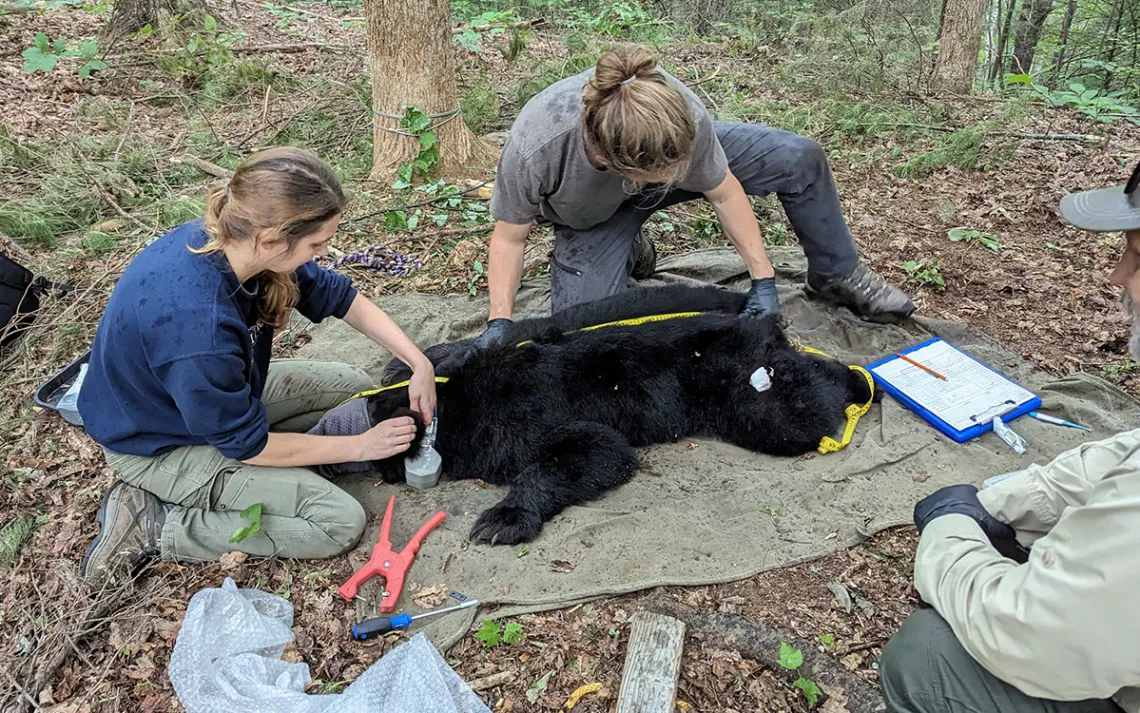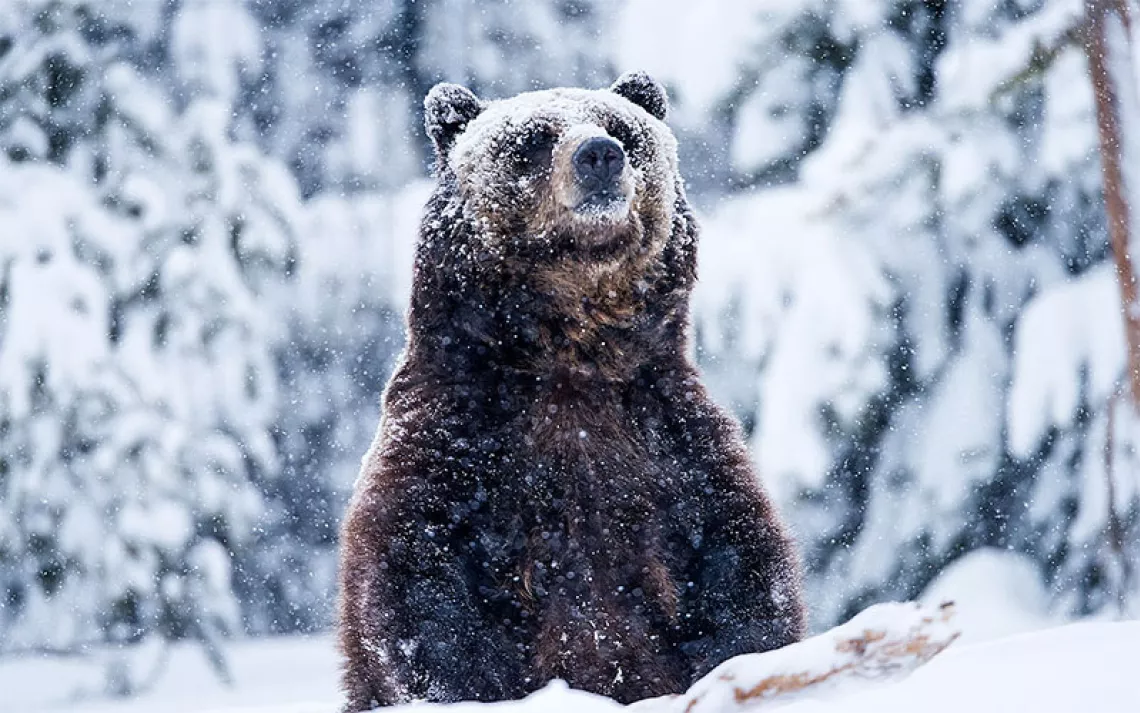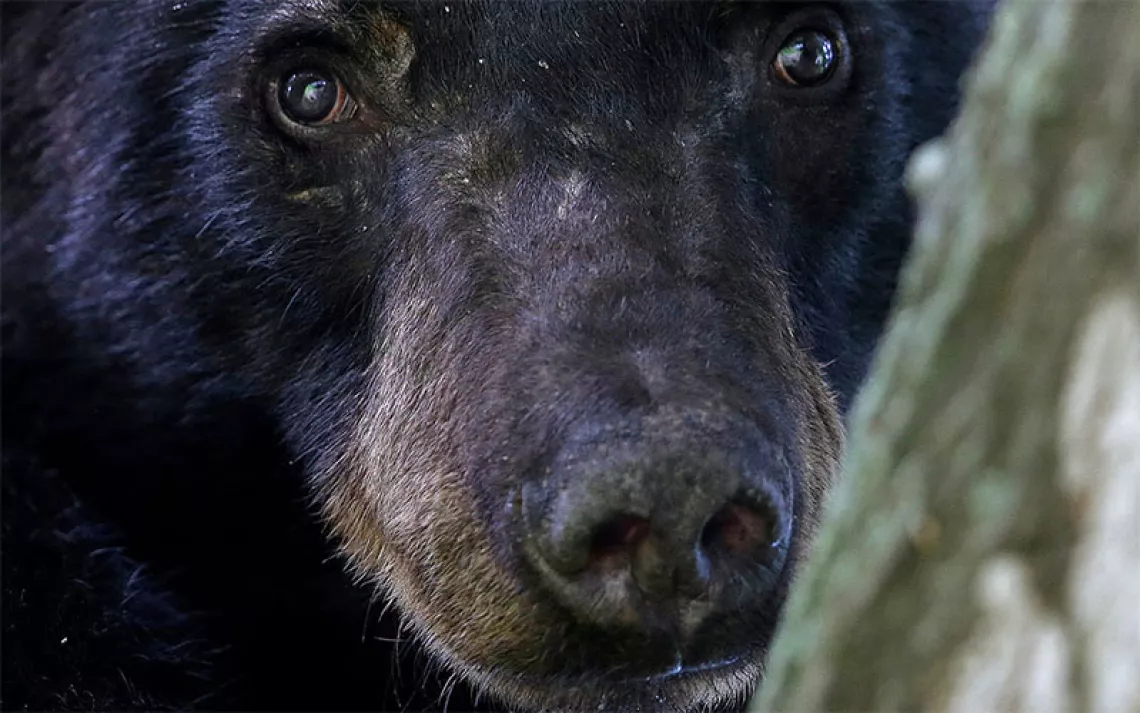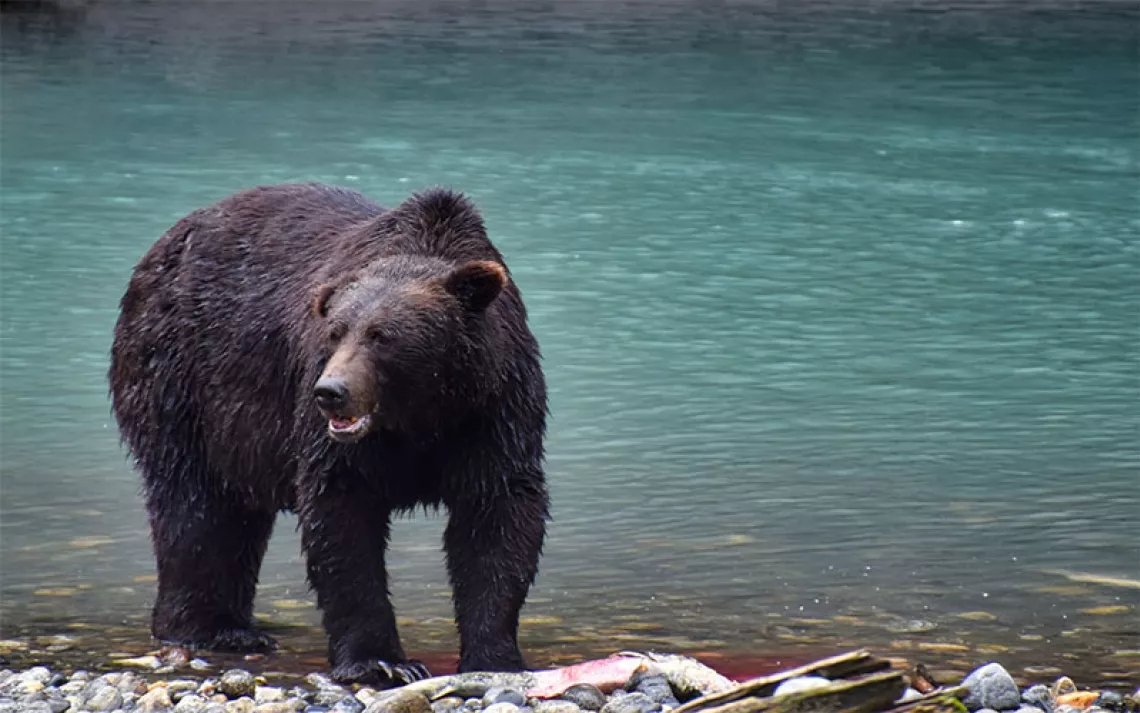Large-Scale Wildlife Crossings Head East
The I-40 Pigeon River Gorge Wildlife Crossing Project is making the roads safer for people and animals

Kristin Botzet and her technician, Logan Parr, collect data from a tranquilized black bear as part of the I-40 Pigeon River Gorge Wildlife Crossing Project. | Photo by Audry Botzet
The town of Maggie Valley, North Carolina, has a reputation for its elk. Visitors often leave the town with elk memorabilia and see the large cervids lounging on lawns, crossing busy roads, and grazing in parks. As they make their way in and out of town, the tourists likely come in on a serpentine stretch of Interstate 40 known as Pigeon River Gorge. The road carries over 28,000 vehicles daily through the mountainous wildlands and protected national forests around the gorge, forming a barrier that splits wildlife habitat asunder.
In June 2023, tragedy struck. One of Maggie Valley’s female elk was killed in a vehicle collision on the main road leading to the interstate. The elk population is small, only about 200, but it’s a healthy, slow-growing population. Researchers predict that climate change will force elk and other animals to migrate northward from these Southern Appalachians. Their migration path will roughly follow the highway through Cherokee National Forest, which means more vehicle-related wildlife deaths.
This wildlife collision risk has been nagging Wanda Payne for many years. As the Division 14 engineer for the North Carolina Department of Transportation (DOT), Payne is responsible for the roads of Maggie Valley as well as the I-40 stretch through Pigeon River Gorge. Drivers in the region are no strangers to run-ins with deer. “But when you start hitting an elk—that’s a much bigger problem,” said Payne. “It would back up traffic. You’re probably looking at a half a day.” There are no quick detours around the gorge's rough, remote terrain. And when a third of the vehicles on the road are trucks hauling commerce, that means supply chains, product deliveries, and sales.
As early as 2017, Payne was looking for clear vehicle-wildlife collision data. Neither DOT nor the highway patrol knew exactly where collisions were happening or how often. At that time, engineers weren't thinking about road ecology—the way animals use roads and road structures like culverts, underpasses, and tunnels to move across the landscape. Collisions were recorded as isolated incidents. And troubling studies have revealed that wildlife collisions were under-represented by crash reports by as much as a factor of three.
“One of the most important aspects of road ecology is you want to have data going in to justify public spending,” said Jeff Hunter, Southern Appalachian director with the National Parks Conservation Association (NPCA). In 2017, when Payne was looking for data, Hunter was working with a group of researchers from Wildlands Network, a science-based nonprofit with plenty of expertise in wildlife highway crossings.
Wildlands Network knew what data the highway engineering team would need, and it brought in Liz Hillard to conduct the research. A team made up of Hillard, Hunter, and others from their two organizations began working on a design for research. They came up with a three-year study integrating data from crash reports, camera traps, and carcass counts. This marked the start of Safe Passage, the collaborative force behind the I-40 Pigeon River Gorge Wildlife Crossing Project. Focusing on the animals that incurred the costliest damage—bear, white-tailed deer, and elk—the Safe Passage research team was speaking Payne's language.
"There are specific ecologies that kind of drive where [wildlife] conflict areas are along the road,” Hillard said. To conduct the research, she personally drove up and down the 28-mile Pigeon River Gorge stretch of I-40, counting roadkill. The final study marked collision “hot spots” on a map, identifying problematic highway structures.
“The epicenter of the elk population is only about six kilometers [3.7 miles] from the highway,” Hillard said. The research included tracking how these large animals moved. Elk are slow, large, and need elbow room, according to Hillard. They follow the meander of rivers, the promise of mates, or the scent of lush grazing grounds. Tracking 13 elk, Hillard documented some interesting findings.
“We had one female elk that crossed the Interstate every year,” she said. According to her, female elk won’t travel far when food is good. But they will travel to have their young. “She crossed 107 times in total, using a kind of underpass where the Appalachian Trail crosses.” Hillard thinks this doe was motivated by the need for more calving space. “She just chose to have her calf on the other side.”
Black bears, on the other hand, are ridge walkers, according to Hillard. Researchers are still studying what makes these human-avoiding animals vulnerable to traffic. “Black bears here in the Southern Appalachian area, they are so keyed in on acorns in the fall,” Hillard said. “We know when we have a bad acorn year, we see a real increase in black bears being killed on roads.”
To understand road ecology, it's important to gather data on the different species' behavior around specific types of road structures. For instance, while elk and bears will not cross under an arch-shaped culvert, they will use a wide, well-lit, box-shaped culvert. In gathering the data, Hillard was baffled by the bear behavior caught on camera at one culvert. It seemed favorable—a box-shaped culvert, short, wide open, and well-lit. But bears would check the culvert out and then move on, never passing through it. Instead, the data showed that bears were dying in collisions on the highway just above the culvert.
Hillard consulted Kristin Botzet, a graduate research assistant at the University of Tennessee. Over two years, Botzet had trapped, collared, and tracked 38 Pigeon River Gorge resident bears. She has a theory about what might be going on with the culvert. “It’s concrete, and there’s no vegetation around it," she said. "If you get a truly wild bear that is not habituated to it, it could be, like, ‘Where’s the vegetation?’” Research from other large wildlife crossing projects suggests that bears are slow to reach habituation. They can take three to five years before using a new crossing structure.
When completed, the Safe Passage study identified 20 hot spots along I-40, specific tunnels and bridges that showed high animal presence—bear at some, deer at others. This was just the data Payne needed to integrate wildlife accommodations into the DOT plan to replace five bridges, and NC DOT was able to commit funding to all of them. The new bridges would be larger, creating wider underpasses that would be more attractive to wildlife. Two bridge replacements included plans to modify the area under the bridges. Construction crews would turn sloped, gravel infill—the DOT standard—into easy walking trails by forming flat, earthen “shelves.”
In April 2023, construction on the gorge's first bridge to include these wildlife mitigations was completed. Cattle guards (gratings set into the road that don’t accommodate hooves) sat at the bottom of the entrance/exit ramps. By November, miles of preventative fencing were in place to keep animals off the interstate and guide them toward the safe crossing. All five bridges in the project will have this fencing.
Payne calls these mitigations “tweaks.” But they're foundational tweaks, proof of concept for a process Payne hopes to see replicated throughout the state. For the first bridge, those "tweaks" cost $586,174, according to Tracy Davids, the communications and outreach arm of Safe Passage. Considering the $6000 to $24,000 cost estimates for a single collision with a deer, bear, or elk, it's a small expenditure.
Wildlife crossings provide a win-win solution for both humans and animals. Multiyear studies have shown that they ultimately reduce vehicle collisions with wildlife by 85 to 90 percent. But realizing them demands extreme collaboration. The Pigeon River Gorge project happened because a diverse coalition of wildlife conservationists, highway patrol officers, park officials, and highway engineers came together. For Payne, the project was a paradigm shift. “It’s definitely been a change of philosophy for me," she said, "really thinking about all of the users of a road and not just concentrating on moving cars from one end to the other.”
 The Magazine of The Sierra Club
The Magazine of The Sierra Club



